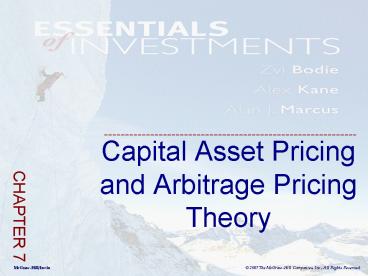Capital Asset Pricing and Arbitrage Pricing Theory - PowerPoint PPT Presentation
1 / 24
Title:
Capital Asset Pricing and Arbitrage Pricing Theory
Description:
Capital Asset Pricing and Arbitrage Pricing Theory CHAPTER 7 Capital Asset Pricing Model (CAPM) Equilibrium model that underlies all modern financial theory Derived ... – PowerPoint PPT presentation
Number of Views:330
Avg rating:3.0/5.0
Title: Capital Asset Pricing and Arbitrage Pricing Theory
1
CHAPTER 7
- Capital Asset Pricing and Arbitrage Pricing Theory
2
Capital Asset Pricing Model (CAPM)
- Equilibrium model that underlies all modern
financial theory - Derived using principles of diversification with
simplified assumptions - Markowitz, Sharpe, Lintner and Mossin are
researchers credited with its development
3
Assumptions
- Individual investors are price takers
- Single-period investment horizon
- Investments are limited to traded financial
assets - No taxes, and transaction costs
4
Assumptions (cont.)
- Information is costless and available to all
investors - Investors are rational mean-variance optimizers
- Homogeneous expectations
5
Resulting Equilibrium Conditions
- All investors will hold the same portfolio for
risky assets market portfolio - Market portfolio contains all securities and the
proportion of each security is its market value
as a percentage of total market value
6
Resulting Equilibrium Conditions (cont.)
- Risk premium on the market depends on the average
risk aversion of all market participants - Risk premium on an individual security is a
function of its covariance with the market
7
Figure 7-1 The Efficient Frontier and the Capital
Market Line
8
Slope and Market Risk Premium
- M Market portfolio rf Risk free
rate E(rM) - rf Market risk premium E(rM) -
rf Market price of risk - Slope of the CAPM
s
M
9
Expected Return and Risk on Individual Securities
- The risk premium on individual securities is a
function of the individual securitys
contribution to the risk of the market portfolio - Individual securitys risk premium is a function
of the covariance of returns with the assets that
make up the market portfolio
10
Figure 7-2 The Security Market Line and Positive
Alpha Stock
11
SML Relationships
- b COV(ri,rm) / sm2
- Slope SML E(rm) - rf
- market risk premium
- SML rf bE(rm) - rf
12
Sample Calculations for SML
- E(rm) - rf .08 rf .03
- bx 1.25
- E(rx) .03 1.25(.08) .13 or 13
- by .6
- e(ry) .03 .6(.08) .078 or 7.8
13
Graph of Sample Calculations
E(r)
SML
Rx13
.08
Rm11
Ry7.8
3
ß
1.0
1.25
.6
ß
ß
ß
m
y
x
14
Estimating the Index Model
- Using historical data on T-bills, SP 500 and
individual securities - Regress risk premiums for individual stocks
against the risk premiums for the SP 500 - Slope is the beta for the individual stock
15
Table 7-1 Monthly Return Statistics for T-bills,
SP 500 and General Motors
16
Figure 7-3 Cumulative Returns for T-bills, SP
500 and GM Stock
17
Figure 7-4 Characteristic Line for GM
18
Table 7-2 Security Characteristic Line for GM
Summary Output
19
Multifactor Models
- Limitations for CAPM
- Market Portfolio is not directly observable
- Research shows that other factors affect returns
20
Fama French Research
- Returns are related to factors other than market
returns - Size
- Book value relative to market value
- Three factor model better describes returns
21
Table 7-4 Regression Statistics for the
Single-index and FF Three-factor Model
22
Arbitrage Pricing Theory
- Arbitrage - arises if an investor can
construct a zero beta investment portfolio with a
return greater than the risk-free rate - If two portfolios are mispriced, the investor
could buy the low-priced portfolio and sell the
high-priced portfolio - In efficient markets, profitable arbitrage
opportunities will quickly disappear
23
Figure 7-5 Security Line Characteristics
24
APT and CAPM Compared
- APT applies to well diversified portfolios and
not necessarily to individual stocks - With APT it is possible for some individual
stocks to be mispriced - not lie on the SML - APT is more general in that it gets to an
expected return and beta relationship without the
assumption of the market portfolio - APT can be extended to multifactor models

